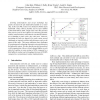Free Online Productivity Tools
i2Speak
i2Symbol
i2OCR
iTex2Img
iWeb2Print
iWeb2Shot
i2Type
iPdf2Split
iPdf2Merge
i2Bopomofo
i2Arabic
i2Style
i2Image
i2PDF
iLatex2Rtf
Sci2ools
ISCA
2005
IEEE
2005
IEEE
Microarchitecture of a High-Radix Router
Evolving semiconductor and circuit technology has greatly increased the pin bandwidth available to a router chip. In the early 90s, routers were limited to 10Gb/s of pin bandwidth. Today 1Tb/s is feasible, and we expect 20Tb/s of I/O bandwidth by 2010. A high-radix router that provides many narrow ports is more effective in converting pin bandwidth to reduced latency and reduced cost than the alternative of building a router with a few wide ports. However, increasing the radix (or degree) of a router raises several challenges as internal switches and allocators scale as the square of the radix. This paper addresses these challenges by proposing and evaluating alternative microarchitectures for high radix routers. We show that the use of a hierarchical switch organization with per-virtual-channel buffers in each subswitch enables an area savings of 40% compared to a fully buffered crossbar and a throughput increase of 20-60% compared to a conventional crossbar implementation.
Hardware | ISCA 2005 | Pin Bandwidth | Router | Router Chip |
Related Content
| Added | 25 Jun 2010 |
| Updated | 25 Jun 2010 |
| Type | Conference |
| Year | 2005 |
| Where | ISCA |
| Authors | John Kim, William J. Dally, Brian Towles, Amit K. Gupta |
Comments (0)

